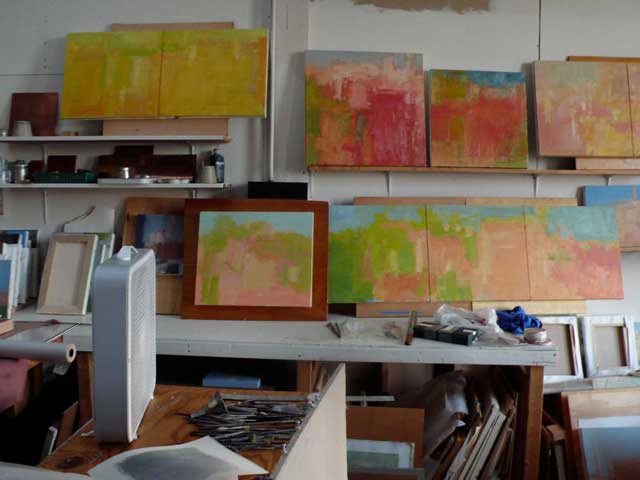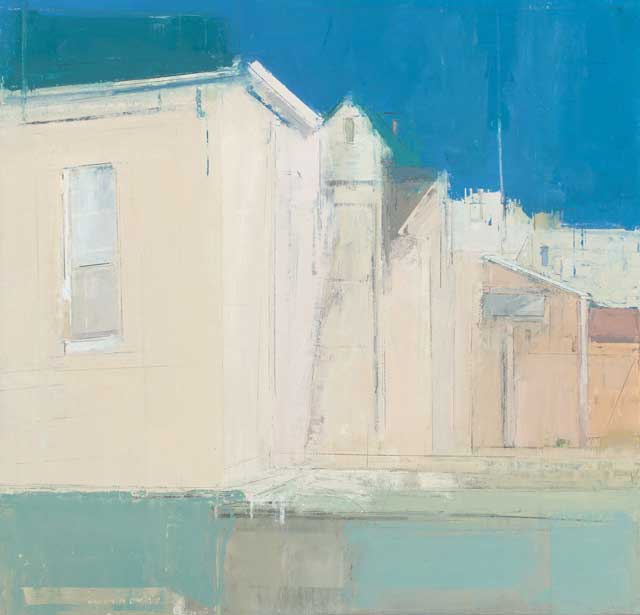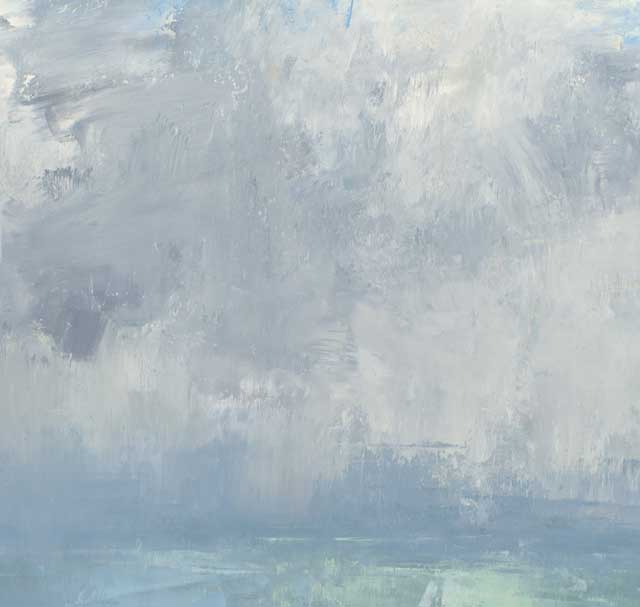What does working from direct observation in the landscape offer you that working in the studio cannot? I’ve seen where you make monoprints in the studio, could you ever paint from memory or drawings in the studio?
SS For me, direct observation in front of nature has always been like the vast treasury in the kings palace, where the gold and precious metals dazzle the eye and we can go in there and bask. But NOT because of anything related to how pretty nature is. So maybe this is a good point for a digression to explain a little bit. Years ago I heard the distinguished Irish archaeologist Dr. Seamus Caufield speak about the relationship between the meanings of “landscape” vs. “scenery”. As I remember he was describing a scene from years ago when a journalist, who was covering the evacuation of some local people from their homes on Horse Island near Belderrig in Co Mayo, asked a local man who was being moved away, “well how do you feel about leaving such beautiful scenery”? And the local man looked around (to what would be to us a hauntingly beautiful place) and said, “well I don’t see anything so good about this, the sea has taken two of my son’s”. The point Caufield was trying to impress upon us (this was at an opening for a local art show in County Mayo) was that landscape and scenery are two different animals. Landscape has to do with deep, resonant power and scenery is about pretty places, nice on the eyes. In this case, the Horse Island locale was landscape not scenery. Some of us go out to connect with landscape resonance, which basically means mood, feeling and abstract strength not with pretty picture material. I’ll go on more about this later. Look, for those of us working within the shadow of the mimetic impulse (making images that have close relationship to things seen), it is a perilous path, always risking pretty pictures, because as Wolf Kahn pointed out some years ago, lets face it, landscape is pretty; but as painters there is another agenda, we are after something else a well.
So following school, I went out into the light of day, and for exposure to the kind of compression one encounters when working with the dynamics of immanent change and shifting time and light; within that something different from the studio can happen, much more urgent given the need to think and act fast. Of course we don’t have to fall asleep in the studio, hardly, and that is the challenge. But for me, given my education and the academic state of mind, it required going outside where everything was in flux to realize that the quality of attack is mostly a state of mind and that it is we who determine how we paint and not something out there. (Francis Bacon was painting in the studio not in a snowstorm although his state of mind was often snowstorm like.)
And I still go outside, but in fact now spend much time during the year working in the studio. A few years ago, with new questions rising to the surface, I had to try something different. When anything becomes too easy, I like to cut down a tree so that it falls across the path and then figure out how to get around it, regardless of whether it takes me off in a completely different direction. Everyone doesn’t like that, but it’s part of the fun. I still spend all the summer outside, and really need to, trying to understand what a place is made of, how am I to respond to it or to myself, and then what am I too make it into two dimensionally. It has nothing to do with the market place but with much broader requirements, with the need for renewal in front of something that can hold me accountable and responsible.
As an art student, I was trained by looking at things and painting or drawing them, over and over and over for 5 years and somehow that extended ritual of looking, as a regimen, as a way of life, as a practice from which I could then grow into and out from, that idea of looking and making a direct response became an embedded habit, and has always been at the center of my concerns. And it is still the acid test in way, the struggle and joy to which I return in order to get straight and also very intoxicated at the same time.
What I’ve learned along the way since leaving school, and I’m relearning this all the time, is that I need to look at the painting as much as looking “out there”. That first, comes the painting, and that no list like accumulation of information is going to grab the eye unless eventually, or really from the very beginning, issues of “form” takes highest priority. From the first touch of the brush, in which the surface is divided between one part and another, the dynamics and structure of pictorial space (and I don’t mean in any way related to realism) is more real than what is “out there”. But that is a very difficult thing to learn and I’m still trying to figure out what finish and resolution mean and what a painting is. Having been trained as a student with such an academic focus posed a paradoxical challenge, which I only understood in a way after the fact. Kind of like tying someone up in chains and then asking them to get out. I often feel like it’s taking a long time to get out, finding little clues along the way and over the last few years, one answer has been to spend a lot of time away from the direct face of nature, with my back to the nature, as in the monotypes and more recently the studio paintings.
What we do in front of nature is our own business and it’s not like we have to be “faithful” to all that we see, and unlike a photograph, absolutely SO much is accessible when we spend time looking at something concrete with which our eyeballs and minds can make intimate contact. Whether it is one meeting or many, aspects of form begin to emerge as we press and coax, it’s like a relationship in which it takes a little bit of time before you can look at each other sustained straight in the eyes, or not much time, depending on what is going on; and what comes out of that is different than either the person or place. This idea of “realism” being perpetrated in some schools and ateliers is a kind of ideological hoax used to impress students who really don’t understand history and are maybe too young or too inexperienced to be able to identify their own feelings. Was Piero a realist or how about Morandi? Perceptual precision or accuracy of looking or feeling has nothing to do with making a careful inventory list or with piling up rationally observed details – just because something is there doesn’t mean we need it.
Last summer, in Italy, one morning I was out painting and I saw a friend drawing down the hill in the vineyard and although the forms in her work may have some root in feeling coming from contact with nature, by no stretch of the imagination does her work reflect what anything looks like per se, the forms are not illusory or imitative of anything, they seem to be about themselves. So that morning she had gone out drawing, into the nature, and even from a distance I could see was periodically, actually often, holding up the pencil to make critical assessments of angle and direction, sense of proportion – as if, as if, that kind of thing was important! And it was and is, even for someone very much abstracting (because abstracting is the core of the whole business anyway), and out there in front of things, one turns to close observation as a way of getting closer. The point is that when we go outside, why are we there if not to engage honestly with a certain kind of understanding that reveals itself In many ways other than imitation of nature or copying.
Initially, I went outside as an alternative to studio work, a refreshment to what seemed like stultifying, predictable routine. I never intended to stay out; it was just a pause. But being out in the light of day knocked my head off, the immensity of everything seemed like a dream, so much possibility and the opportunities offered by spaciousness and shifting light were very exciting. For many, many years I worked outside only, as if it were the only way. I never thought I “knew” enough to go back to the studio and “make it up”. Well, that is a state of mind because; it’s all made up anyway, right, even when directly in front of the motif. I mean, this idea associated with notions of painting as telling the truth is self-deception. Degas had a lot to say about all this, about the painting being mostly invention and artifice. And as Oscar Wilde reminded us, the only thing “real” is the painting itself. We have no obligation to take everything as is, nor can it be done, and nature will not allow herself to be captured. But in a strange way maybe we get closer to nature when we are not directly in front of her.








Very inspiring and wise !
Outstanding! Thanks so much for this interview. He’s one of my favorites and I would love to take his class. He talks about a lot of the things I’m struggling with right now. Maybe Santa will reward me for being good all year.
Some great intense thoughts on painting and seeing. I really like the ideas he was talking about regarding the difference between ‘landscape’ and ‘scenery’, and how painters need to edit out the observed, see-able world, and focus on the construction of what’s happening on the picture plane. His work speaks of a deep involvement with the world, and it shows. Thanks
Great interview Stuart and Larry. Many thanks and will pass this on to the students etc… Best, IH
Thank-you very much Stuart and Larry… nice interview.
It is thrilling to read this discussion which has much to consider and digest.
Yeah, this was a really good interview. Painting as connected to a Kinks chord or whatever it is that grabs us in the world of our senses is really the game and Stuart has a great way of conveying the excitement of it with words and, of course, with his art.
thanks to both you.
dm
Awesome interview, Larry! I ended up doing his workshop in Philly and had a great experience. He is an incredible artist and instructor, as well as a great person. A lot of what was touched on in the interview was discussed in the class as well. Nice to have this wonderful resource to read over and really digest. My seed is taking root!
Hi Larry,
This is one of those interviews that I want to read every day. So many truths and poetic ways of describing the way we think and see as artists. LOVED IT!!
Thanks tons, love your blog!
Happy Holidays to YOU
Terrific interview! Questions and answers all so thoughtful, original, articulate, and helpful. I’d like to take a class in California in spring or early summer.
Absolutely outstanding!
This should be required reading for every art student and I would go s far as saying that every working artist would benefit from reading this often. So full of experience and intelligence! The paintings and drawings are truly beautiful as well.
Thanks for taking the time with this Larry and Stuart.
Thanks very much for doing this interview. Shils has always been one of my favorite painters, and this was wonderful to read and see. I particularly appreciate seeing his sketches, which are amazing.
Great interview on an inspiring artist! Much appreciated.
I got a chance to have Bill Scott in my studio during grad school and was really inspired by his perspective on observational painting. It makes it even more exciting knowing that a painter that I respect as much as Stuart holds Bill in such high regards as well. Great interview! Thanks, Dustin O’Hara
Love your stuff man. Very unique love the abstract qualities and the brightness of the colors. Really rate-type look. Ultra cool.
Great interview on an inspiring artist. Great collections of paintings there.